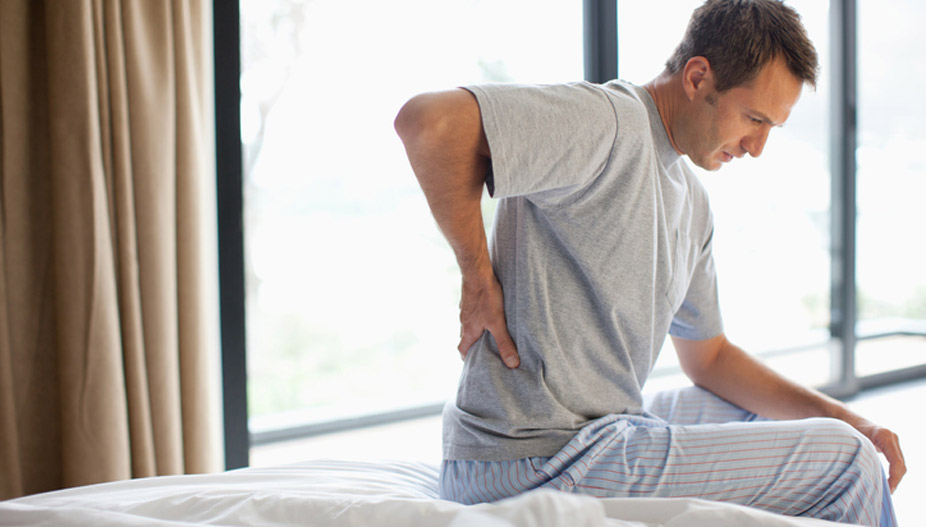Symptoms & Causes of Kidney Pain

Kidney pain due to a tumor or mass is often described as a dull, one-sided "wraparound" ache that is felt from the middle of the back to the lower edge of the ribs. This pain contrast with that secondary to kidney stones which tends to be sharp and intense. Many people incorrectly believe that the kidneys are located in the groin area, but these two bean-shaped organs are actually situated just underneath the ribcage on either side of the spine. Based on this common misconception, some people don’t readily link true kidney pain with the kidneys, but rather erroneously attribute it to another source, such as the back. Unlike back pain though, this pain tends to affect one side more than the other.
What Are the Symptoms of Kidney Pain?
Kidney pain can be acute or chronic and the discomfort typically radiates between the lowest rib and buttock in the back. It can be accompanied by other symptoms, such as:
- Painful urination
- Nausea
- Fever
- Dizziness
- Vomiting
- Blood in urine
- Chills
- Constipation or diarrhea
- Fatigue
- Rash
What Causes Kidney Pain?
Often accompanied by urinary symptoms or fever, kidney pain can stem from a number of causes, including:
- Hemorrhage – Bleeding in a kidney
- Kidney stones
- Renal vein thrombosis – A blood clot in a kidney vein
- Salpingitis – Inflammation of a fallopian tube (in a female)
- Arteriosclerosis – The hardening of an artery leading to a kidney
- Horseshoe kidney – A condition in which the two kidneys are joined together at birth
- Pyelonephritis – An infection in a kidney
- Hydronephrosis – Swelling in a kidney caused by urinary backup
- Polycystic kidney disease – A genetic condition in which clusters of cysts develop in the kidneys
- Kidney cancer – A tumor in a kidney
While kidney pain can sometimes occur with all of these conditions, it is important to note that this is not always the case. In fact, it is possible to have one of these conditions without experiencing any symptoms at all.
Kidney pain can often be misidentified as back pain, due to the location of the kidneys—underneath the ribcage, near the back. However, kidney pain differs from back pain in a few key ways. For example, kidney pain is often felt on either side of the spine between the ribs and hips while back pain usually occurs in the lower back or butt. What’s more, back pain can often be relieved by movement while kidney pain will only improve with treatment.
Many people also associate kidney pain with kidney stones, but this is not entirely accurate. There is no question that kidney stones can be excruciatingly painful. However, these hard, crystallized mineral deposits are usually relatively painless while they remain within a kidney. It is only after they exit the organ through a ureter that sharp, intense pain (renal colic) typically begins to occur in agonizing waves.
If you experience kidney pain, it is important to see a physician who can provide a proper diagnosis and prompt treatment. At Moffitt Cancer Center, our Urologic Oncology Program features a multispecialty team of medical professionals who can work together to pinpoint the cause of your kidney pain and other symptoms. And, in the event that you are diagnosed with kidney cancer, you can have additional peace of mind in knowing that you are right where you need to be. Drawing on our extensive experience and innovative technologies, we can develop an individualized treatment plan to help you achieve the best possible outcome and quality of life.
Medically reviewed by Brandon Manley, MD Department of Genitourinary Oncology.
If you’d like to discuss your kidney pain with a urologic oncologist at Moffitt Cancer Center, call 1-888-663-3488 or complete a new patient registration form online to request an appointment. We do not require referrals.
Helpful Links:
Kidney (Renal Cell) Cancer
- Adrenal Cancer
- Anal Cancer
- Appendiceal (Appendix) Cancer
- Astrocytoma
- Basal Cell Carcinoma
- Bladder Cancer
- Bone Metastasis
- Brain Cancer
- Brain Tumor
- Breast Cancer
- Cervical Cancer
- Cholangiocarcinoma (Bile Duct Cancer)
- Colon Cancer
- Colorectal Cancer
- Cutaneous Lymphoma (CTCL)
- Ductal Carcinoma In Situ
- Endometrial (Uterine) Cancer
- Esophageal Cancer
- Gallbladder Cancer
- Gastrointestinal Carcinoid Tumor
- GIST (Gastrointestinal Stromal Tumor)
- Glioblastoma
- Head and Neck Cancer
- HER2 Positive Breast Cancer
- Hodgkin Lymphoma
- Inflammatory Breast Cancer
- Invasive Ductal Carcinoma
- Kidney (Renal Cell) Cancer
- Leukemia
- Liver (Hepatocellular) Cancer
- Low-Grade Glioma
-
Lung Cancer
- Signs and Symptoms
- Diagnosis
- Treatment
- FAQs
- Lung Cancer Early Detection Center
- Lung Cancer Screening and Surveillance Program
- Lung Nodules
- Lung Surveillance Clinic
- Metastatic Lung Cancer
- Recurrence
- Survival Rate
- Your Lung Cancer Specialists
- Lung and Thoracic Tumor Education (LATTE)
- Thoracic Clinic Updates
- Insurance & Financial Information
- Lymphomas (Hodgkin and Non-Hodgkin)
- Melanoma
- Meningioma
- Merkel Cell Carcinoma
- Mesothelioma
- Metastatic Breast Cancer
- Multiple Myeloma-Plasma Cell Tumor
- Myelodysplastic Syndromes (MDS)
- Neuroendocrine Tumor
- Neurofibromatosis
- Non-Hodgkin Lymphoma
- Oral Cavity (Mouth) Cancer
- Oral Cavity or Throat Cancer
- Osteosarcoma
- Ovarian Cancer
- Pancoast Tumor
- Pancreatic Cancer
- Penile Cancer
- Pituitary Adenoma
- Prostate Cancer
- Rectal Cancer
- Sarcoma
- Skin Cancer (Nonmelanoma)
- Skull Base Tumors
- Small Intestine Cancer
- Spinal Tumor
- Squamous Cell Carcinoma
- Stomach (Gastric) Cancer
- Testicular Cancer
- Throat Cancer
- Thymoma
- Thyroid Cancer
- Tongue Cancer
- Tracheal Cancer
- Triple Negative Breast Cancer
- Vaginal Cancer
- Vulvar Cancer
